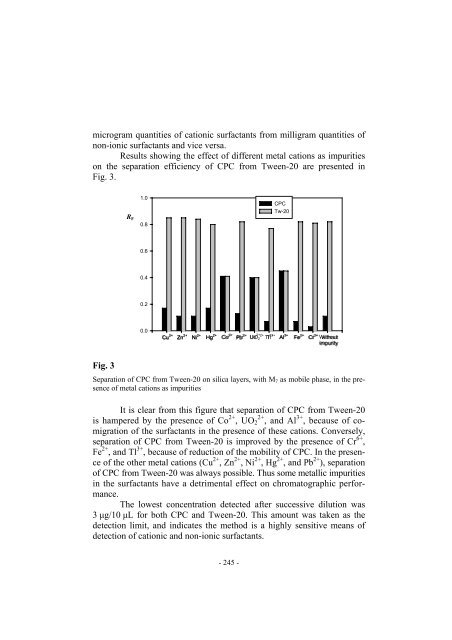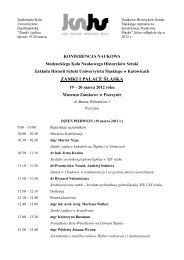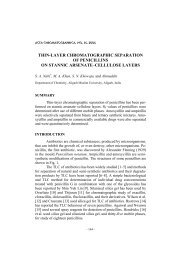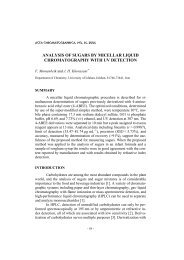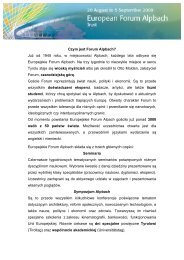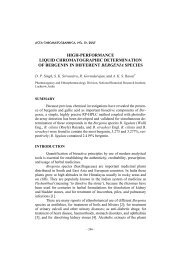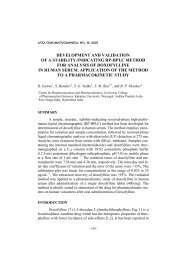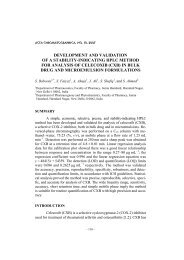Silica thin layer chromatographic separation of cetylpyridinium ...
Silica thin layer chromatographic separation of cetylpyridinium ...
Silica thin layer chromatographic separation of cetylpyridinium ...
You also want an ePaper? Increase the reach of your titles
YUMPU automatically turns print PDFs into web optimized ePapers that Google loves.
microgram quantities <strong>of</strong> cationic surfactants from milligram quantities <strong>of</strong><br />
non-ionic surfactants and vice versa.<br />
Results showing the effect <strong>of</strong> different metal cations as impurities<br />
on the <strong>separation</strong> efficiency <strong>of</strong> CPC from Tween-20 are presented in<br />
Fig. 3.<br />
R F<br />
1.0<br />
0.8<br />
CPC<br />
Tw-20<br />
0.6<br />
Rf<br />
0.4<br />
0.2<br />
0.0<br />
Cu 2+ Zn 2+ Ni 2+ Hg 2+ Co 2+ Pb 2+ Uo UO 2+ Tl 2+ 2 Tl 3+ Al 3+ Fe 2+ Cr 6+ Without without<br />
impurity<br />
Fig. 3<br />
Metal ions<br />
Separation <strong>of</strong> CPC from Tween-20 on silica <strong>layer</strong>s, with M 7 as mobile phase, in the presence<br />
<strong>of</strong> metal cations as impurities<br />
It is clear from this figure that <strong>separation</strong> <strong>of</strong> CPC from Tween-20<br />
is hampered by the presence <strong>of</strong> Co 2+ , UO 2 2+ , and Al 3+ , because <strong>of</strong> comigration<br />
<strong>of</strong> the surfactants in the presence <strong>of</strong> these cations. Conversely,<br />
<strong>separation</strong> <strong>of</strong> CPC from Tween-20 is improved by the presence <strong>of</strong> Cr 6+ ,<br />
Fe 2+ , and Tl 3+ , because <strong>of</strong> reduction <strong>of</strong> the mobility <strong>of</strong> CPC. In the presence<br />
<strong>of</strong> the other metal cations (Cu 2+ , Zn 2+ , Ni 2+ , Hg 2+ , and Pb 2+ ), <strong>separation</strong><br />
<strong>of</strong> CPC from Tween-20 was always possible. Thus some metallic impurities<br />
in the surfactants have a detrimental effect on <strong>chromatographic</strong> performance.<br />
The lowest concentration detected after successive dilution was<br />
3 µg/10 µL for both CPC and Tween-20. This amount was taken as the<br />
detection limit, and indicates the method is a highly sensitive means <strong>of</strong><br />
detection <strong>of</strong> cationic and non-ionic surfactants.<br />
- 245 -


